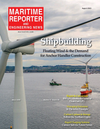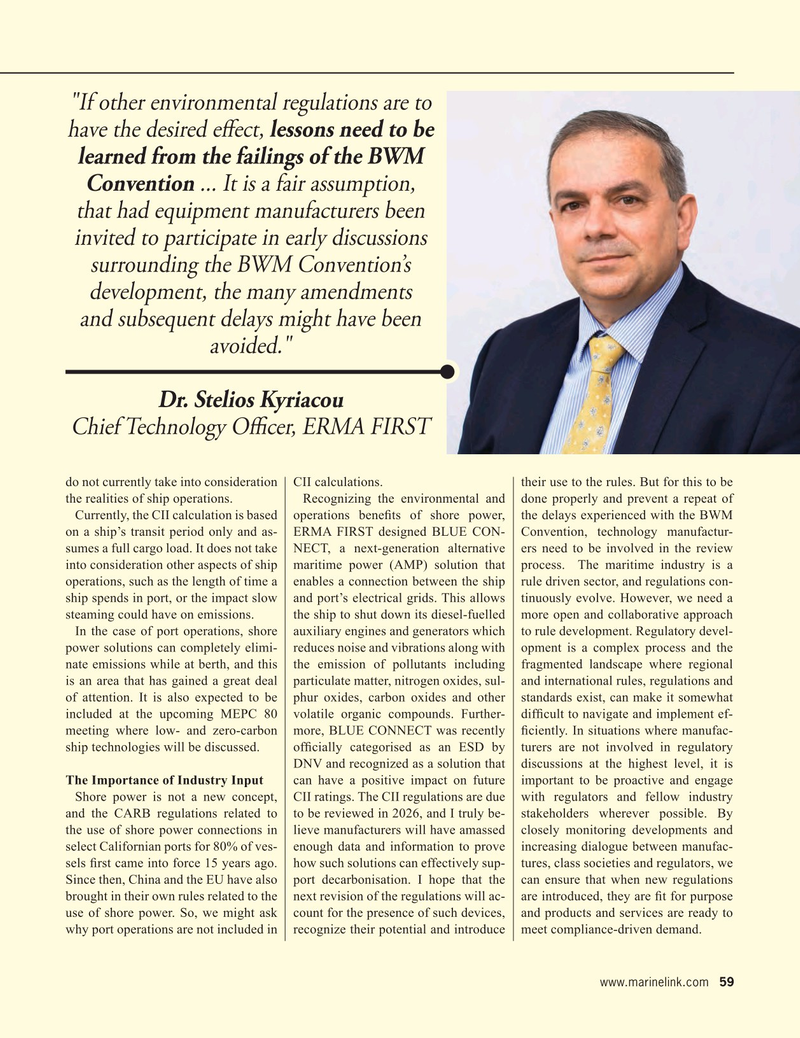
Page 59: of Maritime Reporter Magazine (August 2023)
Shipyard Annual
Read this page in Pdf, Flash or Html5 edition of August 2023 Maritime Reporter Magazine
"If other environmental regulations are to have the desired ef ect, lessons need to be learned from the failings of the BWM
Convention ... It is a fair assumption, that had equipment manufacturers been invited to participate in early discussions surrounding the BWM Convention’s development, the many amendments and subsequent delays might have been avoided."
Dr. Stelios Kyriacou
Chief Technology Of cer, ERMA FIRST do not currently take into consideration CII calculations. their use to the rules. But for this to be the realities of ship operations. Recognizing the environmental and done properly and prevent a repeat of
Currently, the CII calculation is based operations bene? ts of shore power, the delays experienced with the BWM on a ship’s transit period only and as- ERMA FIRST designed BLUE CON- Convention, technology manufactur- sumes a full cargo load. It does not take NECT, a next-generation alternative ers need to be involved in the review into consideration other aspects of ship maritime power (AMP) solution that process. The maritime industry is a operations, such as the length of time a enables a connection between the ship rule driven sector, and regulations con- ship spends in port, or the impact slow and port’s electrical grids. This allows tinuously evolve. However, we need a steaming could have on emissions. the ship to shut down its diesel-fuelled more open and collaborative approach
In the case of port operations, shore auxiliary engines and generators which to rule development. Regulatory devel- power solutions can completely elimi- reduces noise and vibrations along with opment is a complex process and the nate emissions while at berth, and this the emission of pollutants including fragmented landscape where regional is an area that has gained a great deal particulate matter, nitrogen oxides, sul- and international rules, regulations and of attention. It is also expected to be phur oxides, carbon oxides and other standards exist, can make it somewhat included at the upcoming MEPC 80 volatile organic compounds. Further- dif? cult to navigate and implement ef- meeting where low- and zero-carbon more, BLUE CONNECT was recently ? ciently. In situations where manufac- ship technologies will be discussed. of? cially categorised as an ESD by turers are not involved in regulatory
DNV and recognized as a solution that discussions at the highest level, it is
The Importance of Industry Input can have a positive impact on future important to be proactive and engage
Shore power is not a new concept, CII ratings. The CII regulations are due with regulators and fellow industry and the CARB regulations related to to be reviewed in 2026, and I truly be- stakeholders wherever possible. By the use of shore power connections in lieve manufacturers will have amassed closely monitoring developments and select Californian ports for 80% of ves- enough data and information to prove increasing dialogue between manufac- sels ? rst came into force 15 years ago. how such solutions can effectively sup- tures, class societies and regulators, we
Since then, China and the EU have also port decarbonisation. I hope that the can ensure that when new regulations brought in their own rules related to the next revision of the regulations will ac- are introduced, they are ? t for purpose use of shore power. So, we might ask count for the presence of such devices, and products and services are ready to why port operations are not included in recognize their potential and introduce meet compliance-driven demand.
www.marinelink.com 59
MR #8 (50-60).indd 59 8/3/2023 10:27:34 AM

 58
58

 60
60
